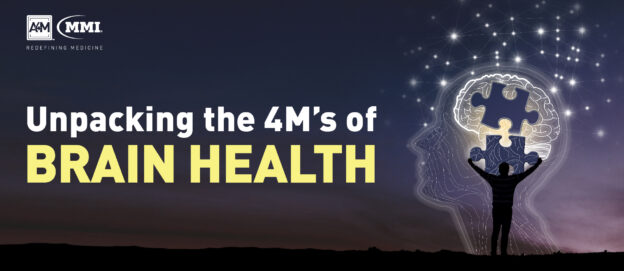Functioning as the command center of the nervous system, the human brain enables many complex processes; as such, maintaining a healthy, well-functioning brain is a critical element of overall health and one of the most important goals in longevity science. As the global population continues to age, the burden of neurological diseases will increase as will the relevance of brain health preservation. In this context, it is vital to understand the intricacies of the brain aging process which contributes to age-related vulnerabilities and is not uniform. It does, however, center around the “4M’s” of brain health – memory, mood, mobility, and mojo – otherwise known as the vital components of optimal brain health.
The 4M’s of Brain Health
Memory
Learning and memory have more recently become a subject of greater importance and increasing investigation in neurobiology. Recent scientific discoveries of cellular mechanisms underlying human learning and memory have sparked growing neuroscientific interest in these fields. Study data has shown that important steps in the learning process are accompanied by structural changes in the central nervous system; biological changes that accompany learning can be seen as an old process put to a new use, or specialized way in which brain continues to evolve after it has matured — a result of neuroplasticity.
Researchers have argued that memory function is associated with specific parts of the brain along with specific neurons that can be recognized for their involvement in the formation of memories. Both short-term and long-term memory are complex and rely on a confluence of many structural, physiological, and psychosocial factors that affect the memory centers. As a result, memory plays a significant role as the first “M” of the 4 M’s of brain health and is one of the aspects most frequently associated with aging and cognitive decline.
Mood
Mood – as underlying mental health – is one of the facets of brain health that is a less often discussed yet critical target for intervention as untreated mental illness and common mood disorders can contribute to adverse or worsened health outcomes. Many prior studies have found that mood can influence perception, motivation, decision-making, social interactions, as well as even more basic cognitive processes such as memory and attention, all of which can have a profound impact on human functioning and therefore, overall health and wellbeing.
The brain is largely responsible for thoughts, feelings, actions, and associated emotions that humans experience. The amygdala, insula, and periaqueductal gray are some of the regions that make up the brain’s limbic or emotion system and thus, the areas that are involved in conjuring feelings. Maintaining optimal mood levels and managing mental illness where it occurs is essential as complications in this area can have adverse effects on brain and physical health. For instance, symptoms of depression can resemble signs of dementia or they can be an indicator of cognitive impairment, especially in the case of mood disorders which develop later in life.
Mobility
The third component of the 4M’s is mobility – a crucial capability of both the body and brain. Chronic exercise has demonstrated positive effects on various areas of the human body, including the cardiovascular and musculoskeletal systems, while also proving to improve cognitive functioning and reduce the risk of dementia along with other neurodegenerative diseases. Research has found that maintaining mobility through exercise helps maintain brain fitness by preserving hippocampal volume and white matter tract integrity thereby improving memory processing and working to prevent age-related cognitive decline.
To better understand the effects of fitness on structural brain changes, a 2014 study published in Sports Health examined the magnetic resonance images from 55 older adults with a mean age of 66.5 years without cognitive impairment. Researchers reported a loss of gray and white matter – in the prefrontal, superior parietal, and middle/inferior temporal cortices – that was correlated with increased age. These images were analyzed to assess the degree to which fitness level moderated changes in tissue loss; the same areas affected by age-related decline exhibited the greatest sparing effects as a result of cardiovascular fitness. The team of investigators demonstrated that high cardiovascular fitness allowed for greater activation in brain regions related to attentional control suggesting that fitness level may be a valid parameter in predicting structural changes related to improved cognitive function, memory, and task completion.
Mojo
The final element of the 4M’s of brain health is mojo, defined as the ability to function at Peak Human Potential as a result of optimal nutrition and physical health. Some experts consider motivation to be a central component of mojo, or individual drive. However, motivation and the interplay of neurotransmitters and other neuropeptides are complex systems which play an integral role when balanced in motivation, mojo, and achievement. Individual motivation is also an intricate factor with many behavioral researchers agreeing that broader aspects of general motivation – or a lack there of – have a neurological basis.
Considering the four specific elements of brain health, it is important to effectively target health interventions in order to optimize human functioning and protect brain health throughout the aging process. Clinicians are invited to attend the upcomingA4M Brain Health Summit: Addressing the 4M’s of Brain Aging event which will delve deeper into the 4M’s of brain health, aging, and the various biological mechanisms associated. To learn more about the 4M’s in particular, practitioners can join the The 4M’s of the Aging Brain: Memory, Mood, Mobility, and Mojo session on Saturday, June 26, 2021, led by neurology expert Sheldon Jordan, MD.

